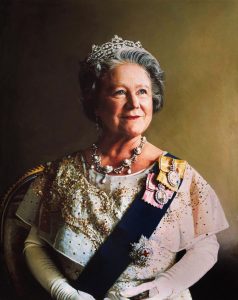
Queen Elizabeth the Queen Mother
Elizabeth Angela Marguerite Bowes Lyon (4 August 1900 – 30 March 2002) was the Queen consort of King George VI. After her husband’s death, she was known as Queen Elizabeth The Queen Mother, to avoid confusion with her daughter, Elizabeth II. Queen Elizabeth The Queen Mother was the last Queen consort of Ireland and Empress consort of India.
Queen Elizabeth The Queen Mother was an advocate of homeopathy, a Patron of the British Homeopathic Association, and a patient of Sir John Weir and Margery Grace Blackie,
Born into a family of Scottish nobility, her father Claude Bowes-Lyon, who was styled Lord Glamis from 1865 to 1904, inherited the Earldom of Strathmore and Kinghorne in 1904. Elizabeth, youngest daughter and the ninth of ten children born to Glamis and his wife Cecilia Cavendish-Bentinck, came to prominence in 1923 when she married Albert, Duke of York (later King George VI), the second son of King George V and Queen Mary.
As Duchess of York, Elizabeth – along with her husband and their two daughters Elizabeth (later Elizabeth II) and Margaret – embodied traditional ideas of family and public service. She undertook a variety of public engagements, and became known as the “Smiling Duchess” because of her consistent public expression.
In 1936, her husband unexpectedly became King when her brother in law, Edward VIII, abdicated in order to marry the American divorcée Wallis Simpson. As Queen consort, Elizabeth accompanied her husband on diplomatic tours to France and North America in the run-up to World War II.
During the war, her seemingly indomitable spirit provided moral support to the British public, and in recognition of her role as a propaganda tool, Adolf Hitler described her as “the most dangerous woman in Europe”.
After the war, her husband’s health deteriorated and she was widowed at the age of 51 in 1952.
On the death of her mother in law Mary of Teck in 1953, with her brother in law living abroad and her elder daughter Queen at the age of 25, Elizabeth became the senior member of the Royal Family and assumed a position as family matriarch.
In her later years, she was a consistently popular member of the family, when other members were suffering from low levels of public approval. She continued an active public life until just a few months before her death at the age of 101, seven weeks after the death of her younger daughter, Princess Margaret.
According to her official biographer, William Shawcross, Elizabeth was first introduced to homeopathy by her husband. However, after the King’s leg was hurt in a riding accident her unfamiliarity with homeopathy is apparent. In a letter to a Dr. Varley in December 1930 she wrote:
Dear Doctor Varley,
I am writing to ask you whether your would mind if Doctor Weir came to see the leg whilst you are dressing it this evening. My husband is a very nervy person (which I expect you have noticed), and he has great faith in his little homeopathic powders, and Dr Weir is a homeopathic doctor. My husband is so afraid of not keeping fit, and if you don’t mind, I really believe that the idea even of these little doses will make him feel more cheerful! It is not the leg that worries him, it is his fitness. It seems almost a religion nowadays does it not? And if you have no objection to Dr Weir seeing the leg, then he can swallow his little powders down.
Elizabeth concluded her letter to Varley by revealing the King’s longstanding relationship with Weir, as well as her own uncertainty regarding the protocols of inviting a homeopathic doctor in alongside an allopathic physician:
I am quite ignorant about etiquette, and I hope that it is alright suggesting this. Dr Weir is an old friend of my husband’s, but he has not asked him to come in yet before asking you. If it is alright, my husband though he might look on whilst you are looking at the leg, and then he can swallow down his powders with joy.
Evidently Weir’s treatment was effective, for Elizabeth added him to her own medical staff. From that point on she would be a committed supporter of homeopathy, serving until her death as patron of the British Homeopathic Association. She would also retain the services of a royal homeopathic physician, Margery Blackie replacing Sir John Weir, Anita Davies following Blackie. Elizabeth’s embrace of homeopathy was transmitted to her children, and she was also said to have been responsible for her grandson, Prince Charles, becoming interested in homeopathy.


Great article!
To add, just a few lines:
The Queen Mother, was also treated and followed with homeopathy with (my previous tutor) Dr Trevor Cook, founder of the British Institute of Homeopathy. After her death, Prince Charles wrote a letter to The British Institute of Homeopathy, thanking all support from The British Institute of Homeopathy, and Homeopathy all her life!